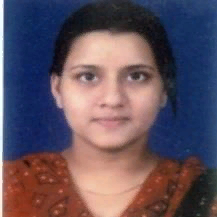
Shikha Thakur
Work place: Department of Electrical and Electronics Engineering, Uttar Pradesh Technical University SRMS College of Engineering and Technology, Bareilly (U.P), India
E-mail: sthakur0407@gmail.com
Website:
Research Interests: Engineering, Computational Engineering, Computational Science and Engineering
Biography
Shikha Thakur received Bachelor of Engineering degree in Electronics and Instrumentation in the year 2009 from MJP Rohilkhand University, Bareilly, India. She is currently working towards her Master’s Degree in Control and Instrumentation at Rajasthan Technical University, Kota, India. Presently, she is working as Assistant Professor in the Department of Instrumentation and Control in SRMS, India. She has presented research paper in national and international conferences her research interests include electronics, biomedical instrumentation etc
Author Articles
Analysis of the Functional Relationship between Electrocardiographic Signal and Simultaneously Acquired Respiratory Signals
By Shikha Thakur Rakesh Kumar Saxena
DOI: https://doi.org/10.5815/ijigsp.2015.09.05, Pub. Date: 8 Aug. 2015
Clinically, ECG is a potential tool used in the applications evaluating electrical activities of heart, functioning and providing solution to problems associated with it. Among such, the relationship (correlation) between respiration and electrocardiographic signal has attracted attention in past decades. In this research, a Welch spectrum estimation approach was utilized for normalizing cross spectrum analysis between these two signals. This approach can be useful while diagnosing diseases like pulmonary embolism, coronary lung diseases, Deep vein thrombosis and other diseases related to heart, from the knowledge of existing coherence bonding between these signals. This research applies the above approach to human subjects, whose ECG and respiratory signal annotations has been evaluated and were sampled at 100 samples/ second (sampling rate). The different respiratory signals are taken from Chest (CRSP), abdominal (ARSP) and oronasal regions (NRSP). The annotated signals for all the four subjects, discussed in this paper were obtained through a non-invasive test, which is medically well known as impedance phlebography, or impedance plethysmography. The numbers of samples, under the analysis were 6000 for each signal. The data was acquired from recording database of physionet. For this examination the mean square coherence (MSC) was chosen as an excellent candidate. The results imply that the mean of MSCs is found continuously decreasing in chest respiration. Secondly, the results showed maximum coherence between ECG and corresponding respiratory signal in three subjects is in Abdominal (ARSP) region (i.e. having maximum value greater than 0.5). Lastly, above analysis was analyzed over the fourth subject's data and under observation it was found, exceptionally that, the value of coherence for all respiratory patterns showed a poor functional association or simply coherence between the signal i.e.Coh2 below 0.5 in the abdominal region (ref.Fig.5) and the reason suggested could be chronic lung disease while the results show higher values, that is between (0.5 < coherence <1) in other two. Further, we show that the coherence peak reflects that the one physiological signal is synchronized with another signal of same nature at a particular frequency, here it is 0 to 35 Hz frequency band and combined analysis is shown through a Boxplot, from three regions showing maximum value of coherence upper quartile in abdominal region for three healthy subjects with maximum value of peak in the same region. This paper also presents a platform to dissolve the problem pertaining in an individual related to deep vein thrombosis, hypoxemia (blood level <90%) [16] and related diseases by estimating the coupling associated between saturated oxygen content (SO2) with respiratory patterns, in order to detect dysfunctioning clinically, also for efficient heart working. Thus, the research shows successful attempt to investigate the interaction of the PS of ECG signal and respiratory signals. The work presented in this paper can further be extended by adopting different method and either by defining a vector array element for maximum number of coherence value that could be beneficial for detecting diseases like sleep apnea on basis of minimum or maximum occurrence of peaks.
[...] Read more.Other Articles
Subscribe to receive issue release notifications and newsletters from MECS Press journals